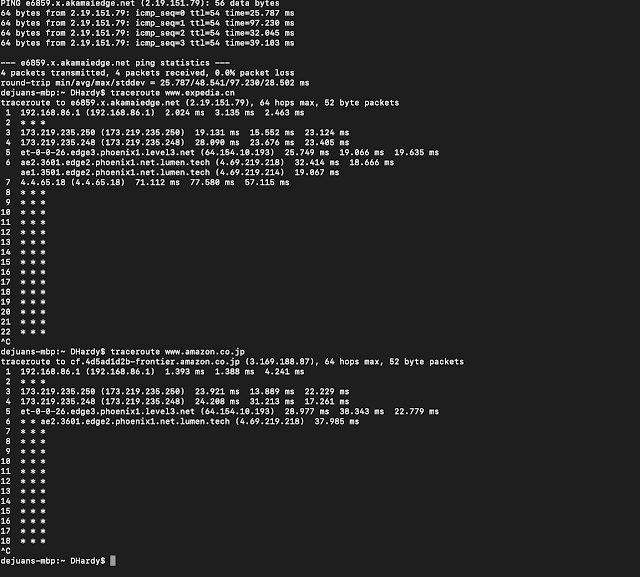Traveling Through A Network
Ping and traceroute commands help us understand how data travels through networks. By using these tools, I observed how packets move between different locations and how network conditions affect performance.
Ping Activity
I tested three websites: Google.com (USA), Amazon Japan (.jp), and Expedia China (.cn). The ping results showed:
- Google.com: Had a fast response time that averaged 50.5ms and received no packet loss.
- Amazon Japan: Had a lower response time and averaged around 28.1ms, which was most likely due to a nearby CDN server.
- Expedia China: Response times varied significantly from 25.7ms to 97.2ms and was likely due to congestion or routing changes, but no showed no packet loss.
These ping results showed that distance affects response times and that CDN’s can reduce latency.
Traceroute Activity
When running the traceroute command to the same websites, I observed that the number of hops and response patterns varied:
- Google.com: The packets took about 15 hops, were consistent response times between routers and had only minor delays.
- Amazon Japan: Responses stopped after 6 hops, most likely due to Amazon’s security settings that restrict external requests.
- Expedia China: Packets failed after 7 hops, with multiple timeouts which could possibly be due to firewalls or network congestion in China.
A notable observation was the presence of routers with significant delays and occasional timeouts, which could be due to network congestion, security policies, and other limitations.
Comparing Ping and Traceroute Results
Comparing the ping and traceroute results, the primary takeaway is that geographical location directly impacts roundtrip time. Websites closer to my location, such as Google.com, had lower latency and required fewer hops, while websites in distant regions like Japan and China showed more complex routing paths. Also, I observed CDN’s can have a huge effect on latency. Japan’s Amazon site had low ping times and China’s Expedia site showed inconsistencies due to traffic conditions and firewall restrictions.
Using Ping and Traceroute for Troubleshooting
Ping and traceroute are useful tools for diagnosing internet connectivity issues. Some common scenarios where these commands could help are by detecting packet loss and identifying routing issues.
Possible Reasons for Timeouts or Errors
- Firewalls/Security: Some servers may block ping requests.
- Network Congestion: Overloaded routers may drop requests.
- Routing Policies: Some regions can restrict certain traffic.
Conclusion
Ping and traceroute showed how packets travel through different routes. Distance affects speed, but CDNs can reduce delays. The results also highlight how security policies and firewalls can impact network performance. Overall, ping and traceroute are valuable tools for analyzing and troubleshooting network connectivity.


Comments
Post a Comment